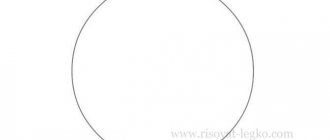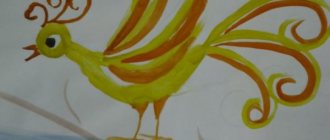Progress of the lesson:
View a presentation about berries .
Tasks: The ability to form coherent speech, listen to other children. Anwser the questions. Increase knowledge of the names of berries .
Educator: Guys, listen to the poem “Currant”
Currant berries
There is an old recipe
Educator: Guys, today I brought such a wonderful chest.
A riddle will tell us what lies in it:
I'm friends with a pencil
Where he passes, he places a drawing. (Paper)
.
Educator: That's right guys, this is paper. How did you guess? What words did you suggest? (children answer)
.
magically draw on it “ Berries on the bushes .”
Educator: Guys, I have another wonderful chest.
On the topic: methodological developments, presentations and notes
The purpose of this lesson: Fostering children's love for decorative and applied arts, Forming the ability to correlate images by shape. Development of attention, logical thinking, observation skills.
Learn to draw a Christmas tree with branches elongated at the bottom.
Drawing material.
summary on the topic of mother's holiday.
Notes on drawing in the middle group on the topic: “Winter Forest” (non-traditional drawing techniques). Goal: To summarize children’s ideas about winter phenomena in nature, to teach them to convey them in rice.
Source
Drawing fruits and vegetables step by step
Vegetables and fruits are not only welcome guests on our tables, but also a powerful layer of creativity of the most famous artists in the world.
Paul Cezanne was fond of drawing still lifes. Pablo Picasso loved to decorate his canvases with vegetables and fruits. And the Dutchman Willem Claes Heda was generally called by art historians “the master of breakfast” - he so skillfully conveyed the mood of the picture with the help of fruits and silverware.
Still life by Willem Claes Heda.
I suggest that you, at least for a moment, imagine yourself as a famous artist by drawing fruits and vegetables in your album.
Lesson on drawing vegetables with colored pencils
If vegetables could talk, they would probably tell you incredible stories about how they appeared in the kitchen.
Europeans initially considered tomatoes brought from South America to be poisonous. That is why for a long time tomatoes decorated window sills, gazebos and greenhouses. Only when the Portuguese figured out how to use them as food, it turned out that tomatoes are not poison at all, but a storehouse of vitamins!
Crushed red peppers became the protagonist of the world's first gas attack. Guess which vegetable was considered a symbol of discord by the ancient Persians? You won't believe it - beets! The crimson-colored fruit with tops was often thrown into the house of enemies.
But garlic, on the contrary, was idolized in different parts of the world. Roman legionnaires wore it on their chests as a talisman, Afghans used garlic as a remedy for fatigue, the ancient Greek physician Hippocrates treated the lungs with it, and the “father of comedy,” the poet Aristophanes, wrote about garlic as a means to maintain courage.
How many interesting and exciting things are hidden in vegetables, modestly lying on the shelves of your refrigerator! So, let's gather up the courage and go ahead - draw a still life with vegetables.
1. First draw the outlines of the vegetables. To make the composition complete and harmonious, try to hide one vegetable a little behind another.
2. Detail the image, giving each vegetable a characteristic shape. Draw the tails and leaves.
3. Trace the outline of the vegetables with a gel pen and erase the pencil.
4. The main thing in a still life is to paint it correctly.
Let's start with pepper. Color it with a yellow pencil, avoiding the highlight area. Fill in areas of depressions and irregularities with orange and brown pencils.
5. Make the color more saturated using different shades of orange. A little attentiveness and perseverance - and you will succeed!
6. Color the stem. The pepper drawing is ready.
7. Shade the radishes with a pink pencil. Deepen the color with burgundy and red pencils.
8. Use green, yellow and brown pencils to color the cucumbers.
9. The bulb can be colored with yellow, orange and shades of brown. Don't forget the glare!
If you want to draw garlic instead of an onion, it is better to paint it with shades of pink, purple and blue.
10. The handsome tomato will be a rich red color. Brown and burgundy pencils will help to enrich the color of the tomato.
11. And finally, shade the surface of the table on which the vegetables lie. A dark brown pencil will help to correctly depict shadows around vegetables.
How to draw fruits step by step?
Fruits can also tell you a lot of unexpected things about themselves. Did you know that a banana is actually a berry, and strawberries are botanically called nuts?
An ordinary apple can easily replace a cup of coffee in the morning - it invigorates just as much and is not harmful to your health. A ripe watermelon will lift your mood better than chocolate, and lemon will help you become slimmer.
Draw a simple still life of fruit - decorate the kitchen with a vitamin rainbow of strawberries, pears, apples, watermelons, lemons and oranges.
1. First of all, draw the outlines of the fruit in the form of geometric shapes. Even if the lines are barely noticeable, they will still have to be erased later.
2. Draw a strawberry and an apple. Cover the surface of the strawberry with small speckled seeds, and mark a highlight area on the apple.
3. Next up are orange and lemon slices. If we draw the outlines of the fruit peel with a clear bold line, then the middle of the lemon with the slices is thin, barely noticeable.
Pay attention! One of the circles will be partially hidden behind the lemon, so do not press too hard on the pencil.
4. Draw a lemon. Using specks, give the surface of the lemon a characteristic relief.
By the way, the ancient Romans were not afraid of lemons like fire. They considered this fruit to be the strongest poison, worthy only of destroying moths. What kind of tea parties are there!..
5. In the background, draw two slices of watermelon and a pear.
The fruit composition is ready. All that remains is to paint.
Drawing a fruit basket
A vitamin fruit basket will be a wonderful addition to your kitchen interior.
The vine, a symbol of fertility, wealth and prosperity, in combination with pears and sunny peaches, symbolizing youth and the rebirth of life, will effectively decorate a dacha or a school canteen. How do you like the idea of giving the school a picture you drew yourself from the whole class?
It is very simple to depict a fruit basket on whatman paper or in an album.
1. First make sketches of the basket and fruits: grapes, peach, plum and pear.
2. Draw a basket and fruits using smooth lines. Try to maintain symmetry.
3. Paint over the fruit as shown in the picture, with shadows and highlights.
4. After applying the shading, blend the pencil to achieve a smooth transition of colors. Draw weaving on the basket.
Ready!
Finally, catch a selection of vegetables and fruits that are easy to draw with paints, watercolors or wax pencils. Practice correctly depicting colors, the play of light and shadow on fruits, and surprise your loved ones with your artistic talents every day.
Read also:
Noticed a spelling mistake? Select it with the mouse and press Ctrl+Enter
pustunchik.ua
Pencil drawing lessons - vegetables, fruits and berries
How many interesting vegetables grow in the garden, and how many sweet fruits and berries can be collected in the garden. Take a pencil and paper, carefully following the diagram, draw a picture along the contours.
Pencil drawing lessons on the topic of vegetables, fruits and berries; cucumbers and carrots from the garden; gifts from the gardens: apples, pears, plums and cherries. By drawing pictures step by step, children develop creative skills and learn about the world around them.
Let's get acquainted with visual lessons-schemes of pencil drawing for children.
Drawing "Cucumber"
Scheme of drawing a cucumber in pencil
Material: pencils and paper
Complexity: •
Drawing "Carrot"
Scheme of a carrot drawing in pencil
Material: pencils and paper
Complexity: ••
Drawing "Cabbage"
Scheme of drawing cabbage in pencil
Material: pencils and paper
Complexity: ••
Drawing "Apple"
Scheme of drawing an apple in pencil
Material: pencils and paper
Complexity: •
Drawing "Pear"
Pencil drawing of a pear
Material: pencils and paper
Complexity: •
Drawing "Plum"
Scheme of drawing a drain in pencil
Material: pencils and paper
Complexity: •
Drawing "Watermelon"
Sketch of a watermelon drawing in pencil
Material: pencils and paper
Complexity: ••
Drawing "Strawberry"
Scheme of strawberry drawing in pencil
Material: pencils and paper
Complexity: •••
Drawing "Currant"
Scheme of drawing currants in pencil
Material: pencils and paper
Complexity: ••







